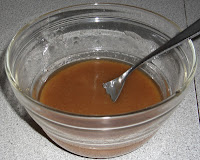I've never baked oatmeal bread before, so I think this is a good way to observe NOM.
Right now I can smell the fruits of my first effort. The bread in the oven smells like oatmeal cookie goodness.
Now out of the oven, here's what the bread looks like:
I am trying to wait for it to cool a bit before tasting it.
This recipe is from a bread book that my friends Velma and Len Dippold gave me. The recipes in Uncle John's Original Bread Book were collected by John Braue's family for generations. His father was a master bread baker in Hamburg before coming to this country in the late nineteenth century. It's been a long time since I've had a recipe book this fun to read!
The recipe is called Grossmutter's Golden-Sunrise Wheat or Oatmeal Brot. Obviously, I'm going with the oatmeal option.
 |
| I love my new book holder! |
I sliced the bread:
It's slightly coarse, chewy, and, with just a hint of oatmeal, more flavorful than white bread. Delicious!
I also baked a whole wheat version. It smelled just as oatmeal-heavenly while baking.
I sliced it:
It's also slightly coarse, chewy, and, with just a hint of oatmeal, has a more complex flavor than regular whole wheat bread. Delicious!
Here's the recipe with my tweaks, because I don't use shortening in bread, I use instant dry yeast, I have dry milk (and water!) but not fresh milk, I'm using loaf pans instead of making round loaves, I know my oven, and I'm just interested in the oatmeal option:
Grossmutter's Golden-Sunrise Oatmeal Brot
Mix together:
2 1/4 C warm water
1/4 C honey
2 T canola oil
Mix together and beat into above mixture until smooth:
2 C (8.5 oz.) all-purpose flour*
1 1/2 T instant dry yeast
1 T salt
2/3 C instant nonfat dry milk
Add:
2 C (6.25 oz.) quick-cooking rolled oats
Add and stir well:
2 C (8.5) C all-purpose flour* [According to the recipe, you shouldn't need the full amount, but that was not my experience.]
Turn the dough out onto a floured surface and knead, adding flour as needed, until elastically smooth. Then return to oiled bowl, turning the dough to oil all surfaces; cover.
Let rise in a warm place until doubled in size. Punch down and form into loaves. Let rise about 45 minutes. Bake at 375 degrees for about 35-40 minutes.
*Or use whole wheat flour (from hard red wheat)























.JPG)























